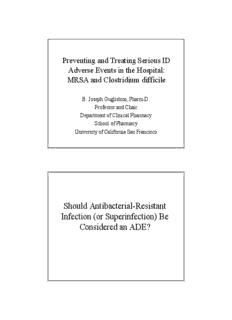
Should Antibacterial-Resistant Infection PDF
Preview Should Antibacterial-Resistant Infection
Preventing and Treating Serious ID Adverse Events in the Hospital: MRSA and Clostridium difficile B. Joseph Guglielmo, Pharm.D. Professor and Chair Department of Clinical Pharmacy School of Pharmacy University of California San Francisco Should Antibacterial-Resistant Infection (or Superinfection) Be Considered an ADE? FDA Definition of ADE FDA categorizes a serious adverse event (events relating to drugs or devices) as one in which “the patient outcome is death, life- threatening (real risk of dying), hospitalization (initial or prolonged), disability (significant, persistent, or permanent), congenital anomaly, or required intervention to prevent permanent impairment or damage.” Cost and LOS Associated with ADE • Additional length of stay associated with an ADE was 2.2 days, and the increase in cost associated with an ADE was $3244. • For preventable ADEs, the increases were 4.6 days in length of stay and $5857 in total cost. • After adjustment, the estimated posteventcosts attributable to an ADE were $2595 for all ADEs and $4685 for preventable ADEs. • Estimated annual costs attributable to all ADEs and preventable ADEs for a 700-bed teaching hospital are $5.6 million and $2.8 million, respectively. (JAMA 1997; 277:307-11) Antibacterial-resistant Staphylococcus aureus is Associated with Increased Cost and LOS • Surgical site infection: MRSA associated with increase in LOS of 5 days after infection. Charges were $29,455 for controls, $52,791 for MSSA, $92,363 for MRSA (Clin Infect Dis 2003; 36: 592) • Bacteremia: MRSA bacteremiaassociated with a median attributable length of stay of 2 days and a median attributable increase in hospital charge of $6,916 (Infect Control Hosp Epidemiol2006; 26: 166) • Ventilator-associated pneumonia: MRSA associated with increase in 5.3 ICU days, 3.8 days LOS, 4.4 days receiving mechanical ventilation, when compared to MSSA (Crit Care 2006; 10: 157) Superinfection Due to C. difficile is Associated with Increased Cost and LOS • Clostridium difficile-associated diarrhea (CDAD) in the critical care unit is associated with increased LOS, i.e. 6.1 D vs 3.0 D, and increased ICU cost, i.e. $11,353 vs $6,028 (Infect Control Hosp Epidemiol 2007; 28: 123) Medicare Payment • As of October 2008, in the United States, Medicare will refuse to pay for conditions that result from preventable errors • “The hospital cannot bill the beneficiary for any charges associated with the hospital-acquired complication.” • Private insurers are also considering adopting the new rules (NY Times) Non-reimbursable Conditions 1. Catheter-associated urinary tract infection 2. Catheter-associated vascular infections 3. Pressure ulcers 4. Objects left during surgery 5. Air embolism 6. Blood incompatibility 7. Mediastinitis 8. Falls Non-reimbursable Conditions (yet to be confirmed) 1. Staphylococcus aureus bacteremia 2. Ventilator-associated pneumonia 3. Clostridium difficile-associated diarrhea Community-Acquired Methicillin Resistant Staphylococcus aureus (CA-MRSA): Epidemiology, Outcomes and Treatment 8 7 6 5 MRSA Admissions/ 4 1000 Admissions 3 2 1 0 1999 2000 2001 2002 2003 2004 2005 (Emerging Infect Dis 2007; 13: 1840) 90000 80000 70000 s n 60000 o ati Cellulitis/Abscess aliz 50000 Postoperative t spi 40000 Device-related o Osteomyelitis H o 30000 N 20000 10000 0 1999 2000 2001 2002 2003 2004 2005 (EmergInfect Dis 2007; 13: 1840) Definitions MRSA Infection • Health care-associated – Community-onset (one of the following) • Presence of invasive device at time of admission • History of MRSA colonization or infection • History of surgery, hospitalization, dialysis, residence in a long-term care facility in previous 12 months – Hospital-onset: positive culture >48hrs after hospital admission • Community-associated: cases with no documented community-onset risk factor Invasive MRSA Infection in U.S. July 2004-December 2005 Healthcare-Associated Community Onset Healthcare-Associated Hospital Onset Community- Associated Unknown (JAMA 2007; 298: 1763) Background: CA-MRSA • Until the current decade, MRSA occurred almost exclusively in hospitalized patients or persons with extensive contact with the health care system • CA-MRSA has caused outbreaks among – Children – Prisoners – Participants on sports teams – Military personnel – MSM Cases of MRSA Infection among St. Louis Rams Professional Football Players in 2003 (Kazakovaet al. N EnglJ Med 2005; 352: 468) Epidemiology • 80-90% of CA-MRSA infections manifest as skin or skin structure infections • Necrotizing pneumonitis, necrotizing fascitis, sepsis also reported • Recurs in patients and spreads within households True or False?Antecedent antibacterial use is associated with increased risk of CA- MRSA? 1. True 2. False (Moran et al. NEJM 2006; 355: 666) Molecular Makeup of CA-MRSA Clone USA300: • Presence of Panton-Valentine leukocidin(PVL) is associated with USA300 (and other CA-MRSA strains) • PVL and/or other virulence factors account for the virulence of USA300 • Generally, methicillinresistance associated with CA- MRSA results in some reduction of biological fitness • USA300 may contain other genomic adaptations that overcome this reduction in fitness • USA300 produces many virulence determinants, including α-hemolysin, enterotoxins Q and K, staphylokinase, proteases
Description: